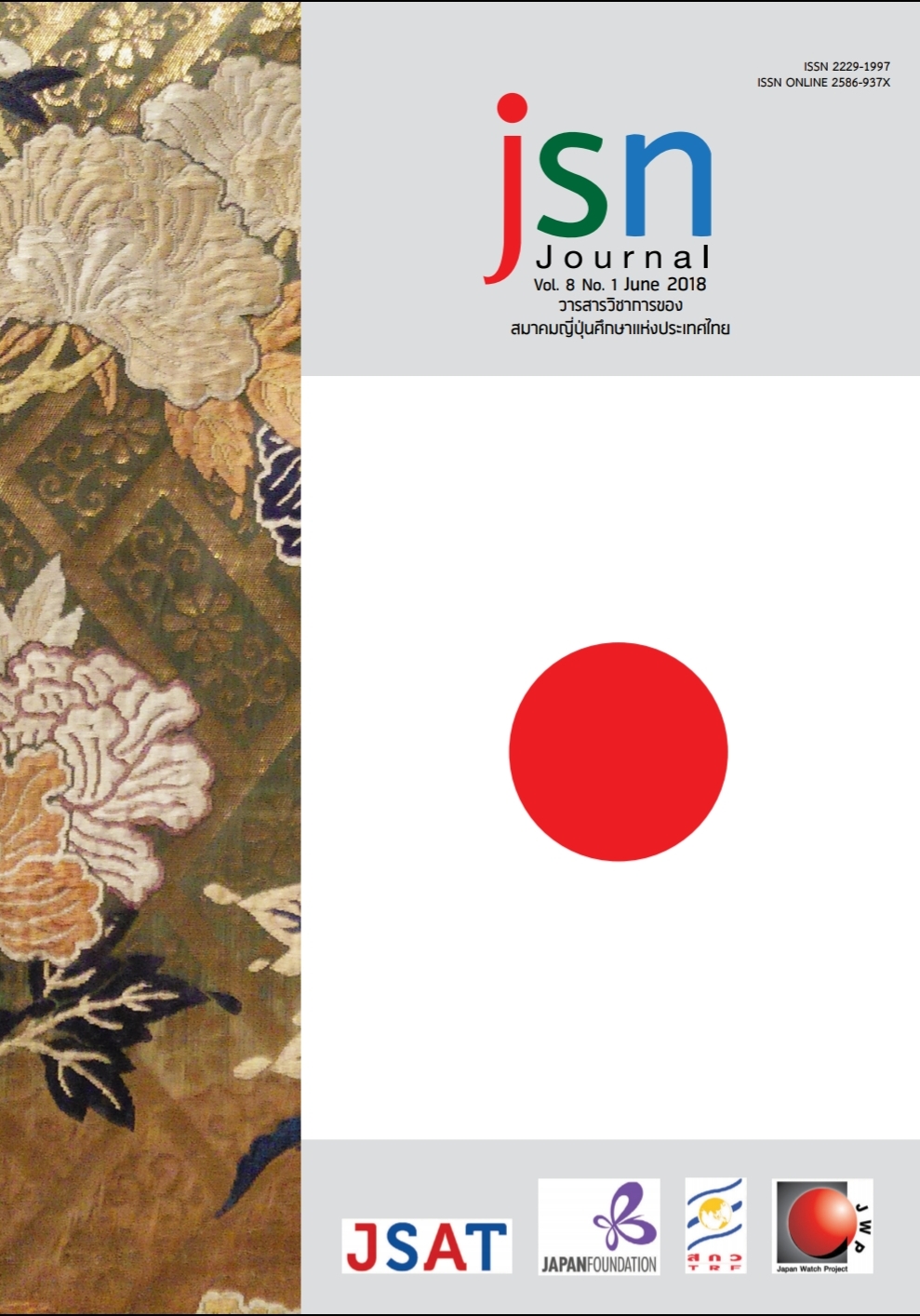Analysis of Kanji Learning Strategies Using Strategy Inventory for Learning Kanji (SILK)
Main Article Content
Abstract
Kanji learning is one of the most difficult areas for Japanese learners from non-Kanji backgrounds. In particular, there are many differences between Thai characters and Kanji, such as the shape of characters, lines, and stroke order. Kanji can be very difficult to learn for the Thais; however, research in this area has not been sufficiently carried out. The purpose of this study was to focus on the following: 1. to derive the Kanji learning strategies of university students in Thailand using SILK (Strategy Inventory for Learning Kanji); and 2. to provide useful Kanji teaching ideas for Japanese lecturers in Thailand. A total of 169 students participated in this study, all of whom were students from the Japanese Department at Mahasarakham University. Utilizing the mixed-methods approach, the research data were collected using a set of questionnaires that consisted of closed-ended and open-ended items. The findings indicated that: 1) the frequency part was the most common, and the sound part was the least used of the Kanji learning strategies; 2) the visual aspects of teaching materials, the use of different types of tests, the media used in Kanji learning, emphasis on the necessity of Kanji, and teaching using a systematic approach to learning should be considered when teaching Kanji to Thai learners. Analysis of Kanji Learning Strategies Using Strategy Inventory for Learning Kanji (SILK)
Article Details
ข้อความและข้อคิดเห็นต่างๆ ในบทความเป็นของผู้เขียนบทความนั้นๆ ไม่ใช่ความเห็นของกองบรรณาธิการหรือของวารสาร jsn Journal
References
Banno, E., Ikeda, Y. (2009). Students’ Attitudes and Strategies toward Learning Kanji: A Survey of Learners from Non-Kanji Background. Journal of International Students Education, 14, 13-20.
Bourke, Barbara. (1996). Maximizing Efficiency in the Kanji Learning Task (Doctoral Dissertation). University of Queensland, Australia.
Furui, S. (2012). Selected Topics from LVCSR Research for Asian Languages at Tokyo Tech. IEICE, E95.D(5), 1183.
Gayathri, H. (2003). Issues in Strategy Classifications in Language Learning: A Framework for Kanji Learning Strategy Research. ASAA e-journal of Asian Linguistics & Language Teaching, 1-14. Retrieved from http://ro.uow.edu.au/cgi/viewcontent.cgi?article=1069&context=artspapers&keyword=learning-a-logographic-language
Hayashi, A. (2011). A Practical Study of Calligraphy in Teaching Japanese Characters: throughTeaching a Sequence of Characters to Thai learners. Japan Foundation Bangkok Nihon Bunka Sentā Nihongo Kiyō, 8, 86-87.[6] Ishii, N., Kim, Y. (2012). A Study of Kanji Learning Strategies and the Processing Strategies by Korean Learners. Journal of Japanese Language Education Association, 60, 52-53.
Jorge, E. (2010). Identifying Language Learning Strategies: An Exploratory Study. Gist Education And Learning Research Journal, 4(1), 94-106.
Kobayashi, H. (2017). Taijin Nihongo Gakusyūsya no Kanji Goi Gakusyū ni kansuru Sutoratejī Siyō no Genjō (Master’s Thesis). Chulalongkorn University, Thailand.
Macaro, E. (2006). Strategies for Language Learning and for Language Use: Revising the Theoretical Framework. Modern Language Journal, 90(3), 320-337.
O’Malley, J., Chamot, A., & Lisa K. (1987). The role of Learning Strategies in Second Language Acquisition. U.S. Army Research Institute for the Behavioral and Social Sciences, Technical Report 742, 1-35.
Rose, H. (2015). Researching Language Learner Strategies, In Brian. P, & Aek. P(Eds.), Research Methods in Applied Linguistics, 421-438. Bloomsbury.
Rubin, J. (1975). What the “Good Language Lerner” Can Teach Us. TESOL Quarterly, 9(1), 41-51.
Shatz, I. (2014). Parameters for Assessing the Effectiveness of Language Learning Strategies. Journal of Language and Cultural Education, 2(3), 96-103.
Somchai, C. (2008). Beliefs and Strategies about Learning Kanji of Thai Learners (Master’s Thesis). Chulalongkorn University, Thailand.
Stephen, S. (2010). Oxford’s Language Learning Strategies: What Every Teacher Should Know(Rebecca Oxford). Bilingual Research Journal, 17(1-2), 117-121.
Strauss, A. and Corbin, J. (1990). Basics of Grounded Theory Methods. Qualitative Sociology, 13(1), 3-20.
Takagi, M. (2016). Beyond the Pictorial: Exploring the semiotic layer of typography in Hanzi/Kanji characters. Typography and Education, 1-9. Retrieved from http://www.typoday.in/2016/spk_papers/Mariko_Takagi_TypographyDay-2016.pdf
Watanabe, T. (2014). Hi Kanjiken Gakusyūsya no tameno Goi Gakusyū Sutoratejī Syakudo no Kaihatsu. Kanji.Nihongo Kyōiku Kenkyū, 4, 30-64.
Wimonwittaya, C. (2014). Taijin Syokyū Nihongo Gakusyūsya no Kanji Gakusyū ni kansuru Jirei Kenkyū:Kanji no Jiyū Kijyutsu Kadai no Kekka kara. JSL Kanji Gakusyū Kenkyūkaishi, 6, 36-43.
Zoltan, Dornyei. (2005). The Psychology of Language Learner: Individual Differences in Second Language Acquisition. London: Lawrence Erlbaum Associates.


